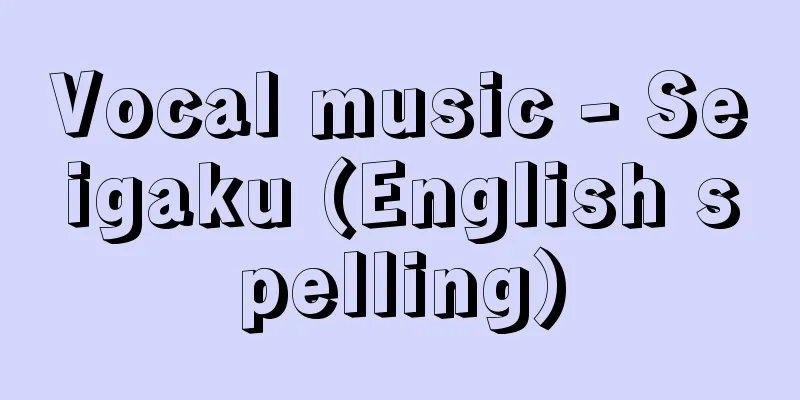Vocal music - Seigaku (English spelling)

|
Music composed and performed for the human voice, with the primary purpose of vocal expression. Opposite of instrumental music. Even if the human voice is used, if the composer's primary interest is in the instrumental music, such as Beethoven's Symphony No. 9 and some of Mahler's symphonies, it cannot be classified as vocal music. The general classification of Western and Japanese vocal music is as shown in . However, this classification is merely expedient, and the nature of each individual case varies widely (for example, some motets and cancatas have secular content). [Masao Ishida] Vocal compositionVocal music naturally accompanies lyrics. When composing a piece of music, the composer's first priority is usually to express the content of the lyrics. Therefore, the form, melody, harmony, etc. of vocal music depend on the lyrics. For example, if a poem, such as a German ballade, deals with medieval historical or imaginary events or romantic stories, it is composed in a through form (composed throughout the entire piece without repetition), while simple folk songs are often composed in a stanza form (the same melody is repeated in each stanza of the poem). Also, when creating a melody for vocal music, a composer must always consider the accent and meaning of the words in the lyrics and apply the appropriate rhythm and sound movement. For example, whether one note is given to one syllable of the words (syllabic style) or whether one syllable is given multiple notes (melismatic style, sung in a vowel singing style) depends on the role that the words play in the song. Also, when expressing intense emotions, increasing and decreasing intervals are often used in those places. [Masao Ishida] Vocal performanceVocalists express a piece according to the composer's intentions, while at the same time adding their own interpretation to the way of expression. To do so, however, they must learn vocal technique as a technical training. Vocalization refers to the act of exhaling air vibrating the vocal cords to produce sound. The voice produced at this time can be beautiful or harsh, depending on the state of the vocalist's entire body, including their posture, breathing (generally abdominal breathing is used, controlling breathing by moving the diaphragm up and down), tongue, lips, teeth, nasal cavity, oral cavity, and thoracic cavity. Vocalists use these organs to select the timbre, quality, volume, and register (chest voice resonating in the thoracic cavity, head voice resonating in the various resonating chambers of the face and head, falsetto, etc.) that best suits their own expression. Western vocal textbooks, including those by Concone, Panovka, Salvatore Marchesi, and Matilde Marchesi, are widely used to learn various vocal techniques. Vocalists are divided into six categories: female soprano, mezzo-soprano, and alto (contralto), and male tenor, baritone, and bass. [Masao Ishida] [Reference] |©Shogakukan "> Classification of vocal music (table) Source: Shogakukan Encyclopedia Nipponica About Encyclopedia Nipponica Information | Legend |
|
人声のために、人声による表現を主たる目的として作曲、演奏される音楽。器楽の対語。人声が用いられていても、作曲者の主たる関心が器楽に向けられている場合、たとえばベートーベンの交響曲第九番やマーラーのいくつかの交響曲の場合は、声楽の枠内には入れられない。声楽の西洋音楽および日本音楽の一般的な分類方法はのとおりである。ただし、この分類は便宜的なものにすぎず、個々の場合でその様相は多様に変化する(たとえば、モテットやカンカータには世俗的な内容をもつものもある、など)。 [石多正男] 声楽の作曲声楽は当然のことながら歌詞を伴う。作曲に際しては、通常その歌詞の内容を表現することが作曲家の最重要課題である。したがって、声楽における形式、旋律、和声などはその歌詞に左右される。たとえば、詩がドイツのバラーデのように中世の歴史上あるいは空想上の事件やロマン的な物語を扱っている場合には、通作形式(繰り返しがなく全曲通して作曲される)で作曲され、素朴な民謡調の歌曲などは有節形式(同じ旋律が詩の各節で繰り返される)で作曲されることが多い。また、作曲家は声楽の旋律を創案する場合、かならずその歌詞がもつことばのアクセントや意味を考慮し、それに適するリズムや音の動きを当てはめねばならない。たとえば、ことばの一音節に一音符を与えるか(シラビックな様式)、一音節に多音符を与えるか(メリスマ的な様式。母音唱法で歌われる)は、そのことばが曲中で果たす役割に左右される。また、激しい感情を表現する場合など、しばしばその箇所に増減音程が用いられる。 [石多正男] 声楽の演奏声楽家は作品を作曲家の意図に従って表現すると同時に、その表現の仕方に自身の解釈を加えようとする。しかしそのためには、技術的な訓練として発声法を学ばなければならない。発声とは呼気が声帯を振動させて声を発生させることをいうが、このときの声楽家の姿勢、呼吸(一般に横隔膜の上下によって呼吸をコントロールする腹式呼吸が使われる)、舌、唇、歯、鼻腔(びくう)、口腔、胸腔など、身体全体の状態によって生み出される声は、美しくも耳障りにもなる。声楽家はこれらの諸器官を駆使して、自身の表現にもっとも適した声の音色、音質、声量、声区(胸腔を中心に響かせる胸声、顔頭部の諸共鳴腔を中心に響かせる頭声、裏声とよばれているファルセットなど)を選ぶ。西洋の声楽教本には、コンコーネ、パノフカ、サルバトーレ・マルケージ、マチルデ・マルケージなどによるものがあり、声楽のさまざまな技法を学ぶため、広く使われている。 なお声楽家は、女性はソプラノ、メゾ・ソプラノ、アルト(コントラルト)、男性はテノール、バリトン、バスの、以上六つに分類される。 [石多正男] [参照項目] |©Shogakukan"> 声楽の分類〔表〕 出典 小学館 日本大百科全書(ニッポニカ)日本大百科全書(ニッポニカ)について 情報 | 凡例 |
>>: Western learning - Seigaku
Recommend
Jiji Shinpo - Jiji Shinpo
A daily newspaper founded by Yukichi Fukuzawa on M...
Kippenberg, A.
…During the time of the East-West division, the c...
Hermaphroditus
A hermaphrodite god in Greek mythology. A compound...
Bolland, J.
...This field of study, which distinguishes betwe...
Orthosilicate - Orthosilicate
...The figure shows the names of these six types ...
Side sword - Outou
…A long sword. It is also written as Yokotana. Th...
Gimirrai
...Following the earlier migration of the Medes a...
Gigue - Gigue (English spelling) French
A fast and lively dance in 6/8 or 12/8 that was p...
Ehrenfest - Paul Ehrenfest
Austrian theoretical physicist. Born in Vienna. H...
Ramune
French Catholic thinker. He was a priest, but grad...
Zonal index
An index that indicates the strength of air flow a...
Vegetative propagation - Vegetative propagation
Also called vegetative reproduction. In a broad s...
Tone [town] - Tone
A town in Kitasoma County in southern Ibaraki Pref...
Le mythe de Sisyphe (English spelling) Le mythe de Sisyphe
…In 1938, he became a reporter for a newspaper in...
Vaccinium myrtillus
… [Kei Yamazaki]. … *Some of the terminology that...









